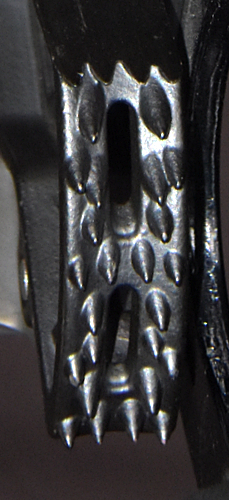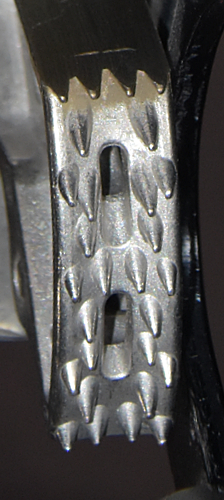Overview
[ Top
| Versions B&C
| Return to H.E.C. Ascenders
]
Version A
(#1933, 2192)
Technical Details
I acquired my SOB from Camping Survivals in 2012. I acquired another pair in 2017 as part of Bob Thrun’s collection.
The SOB is 192 mm. tall, 95 mm. wide, 23 mm. thick, and weighs 208 g.
The rope channel is 15 mm. wide. The cam radius increases from 38 to 56 mm. over an angle of 39°, giving a 29° cam angle. The tooth pattern is (4)(1S1.2S2.1S1)(4)(1S1)^4(4).
The shell is a tall irregular shaped stamping made from 3.5 mm. aluminum alloy sheet metal. A 15 mm. wide rope channel
is formed in the upper portion of one side and a smaller cam channel
lies opposite the first. A hole drilled through both sides of
the cam channel accepts a 5.5 mm. rivet. The cam and cam spring
are mounted on this rivet. The handle below the cam has a soft
"rubbery" hand grip molded into place. The hand grip
has a prominent lip to support the index finger. A 14.7 mm.
sling attachment hole is punched below the handle opening, and
an 9.7 mm. hole is punched below and outside the first. A
14.3 by 17.4 mm. oval hole punched through both sides
of the rope channel provides an attachment point just above the
cam. There is a punched cam stop that contacts the top of the
cam. A stamped reinforcing rip extends from behind the cam and partly down the front and back straps. A 4.8 by 6.4 mm. slot in the rope channel provides some mud relief.
 The cam is a painted (powder-coated??) skeletonized steel casting. The cam radius
increases from 38 to 56 mm. over an angle of 39°, giving a 29° cam angle. The cam has number of conical teeth.
The upper teeth are parallel to the top of the cam, but the lower
teeth have their axes sloping downward. The tooth pattern is (4)(1S1.2S2.1S1)(4)(1S1)^4(4)
where the S in (1S1.2S2.1S1) stands for a single slot and the remaining S stands for a second slot.
The cam is a painted (powder-coated??) skeletonized steel casting. The cam radius
increases from 38 to 56 mm. over an angle of 39°, giving a 29° cam angle. The cam has number of conical teeth.
The upper teeth are parallel to the top of the cam, but the lower
teeth have their axes sloping downward. The tooth pattern is (4)(1S1.2S2.1S1)(4)(1S1)^4(4)
where the S in (1S1.2S2.1S1) stands for a single slot and the remaining S stands for a second slot.
A spring-loaded manual safety bar is riveted to the cam. The
normal action of the safety spring holds the safety against the cam.
When the cam is opened, the shell interferes with the safety bar,
thus preventing opening the cam. If the safety bar is moved away
from the cam (opposing the spring), it will clear the shell and
the cam will open. At full open the safety can be released and
the spring will hold the safety against the back of the shell.
This provides a means of locking the cam open.
The front of ascenders are printed with "CE1282," an up-pointing arrow containing "UP," and "ROPEO8≤Ø≤13" [The right ascender screening omits the "8"]. The rear of each ascender is printed with "SOB®," "EN12841:2006 B," "L (LEFT USE)" on the left ascender and "R RIGHT USE" on the right, "FOR ROPE 10≤Ø≤13mm," [disagreeing with the front screening], "EN567," and "MAX 100kg." The left ascender also has a printed book-with-an-"i" icon. The cams have a cast SOB logo.
The SOB is made in China by the Yue Quing SbengBang Electrical Co., Ltd. (www.cnsob.com). They make a variety of equipment for electrical lineman.
These are well-made ascenders and perform much like the Petzl Ascension. All sharp edges have been
removed. The attachment points are simple yet well-rounded holes
in the shell; even so, I would consider their small radius too
sharp for directly attaching sling ropes. They are probably acceptably
rounded for webbing, but considering the proximity of the attachment
points to the main rope, I would recommend using a small maillon
for most attachments in order to reduce the risk of sling abrasion.
The lower attachment hole could theoretically have the same safety
problems as the one on Clog Version A.
The upper rope attachment hole is located very close to the main
rope. A carabiner through the upper oval attachment hole will
probably drag on the main line.
This ascender has the same pit lip disadvantage as the Clog and other stamped frame ascenders,
but the reinforcing should help prevent bending.
The rubber handle is comfortable enough for my large hands,
but I don't climb by gripping ascenders at their handle. I think
it is better to simply grasp the ascender from above and lift
the ascender in the traditional manner. The safety is usable with one hand.
I'm not sure the extra holes are needed at the base. Except for the Petzl Pompe, I've never found a real need for a second hole. Some people like them, and I might find them more appealing if they were large enough for a standard carabiner to fit through.
The markings for the rope capability are contradictory - the front of the left ascender indicates a rope range of 8≤Ø≤13 mm. while the rear markings on both ascenders indicate 10≤Ø≤13 mm.
The weight limit ("MAX 100kg") printed on the rear of each ascender can easily be less than the weight of a fully loaded caver. Although I know what this means, American courts may not, so I cannot recommend this ascender for heavier cavers or for expedition caving.
|
 |
Warning:
The weight limit ("Max 100kg") printed on the handle can easily be
less than the weight of a fully loaded caver. |
 |
|
[ Top
| Version A
| Return to H.E.C. Ascenders
]
Versions B & C
(#2051 & 2056)
 Technical Details
Technical Details
I acquired my SOB, Versions B & C from amazon.com in 2016. Amazon sold these under the name Leadrise® Outdoor Equipment.
Versions B & C are 192 mm. tall, 96 mm. wide, 24 mm. thick, and weighs 214 g. The rope channel is 15 mm. wide. The cam radius increases from 38 to 56 mm. over an angle of 39°, giving a 29° cam angle. The tooth pattern is (4)(1S1.2S2.1S1)(4)(1S1)^4(4).
The front of ascenders are printed with "CE1282," an up-pointing arrow containing "UP," and "ROPEO8≤Ø≤13" [The right ascender screening omits the "8"]. The rear of each ascender is printed with "SOB®," "EN12841:2006 B," "L (LEFT USE)" on the left ascender and "R RIGHT USE" on the right, "FOR ROPE 10≤Ø≤13mm," [disagreeing with the front screening], "EN567," and "MAX 100kg." The cams have a cast SOB logo.
The main differences between these two versions and Version A are that (1) the reinforcing ribs stamped in the frame have different patterns, and (2) that the cam on Versions B & C are not painted. Version C has a painted cam safety while A & B do not. There are also slight differences in the markings.
The markings for the rope capability are contradictory - the front of the left ascender indicates a rope range of 8≤Ø≤13 mm. while the rear markings on both ascenders indicate 10≤Ø≤13 mm. This has to do with how the ascenders were certified to standards.
The weight limit ("MAX 100kg") printed on the rear of each ascender can easily be less than the weight of a fully loaded caver. Although I know what this means, American courts may not, so I cannot recommend this ascender for heavier cavers or for expedition caving.
|
 |
Warning:
The weight limit ("Max 100kg") printed on the handle can easily be
less than the weight of a fully loaded caver. |
 |
|
[ Top
| Version A
| Versions B&C
]


